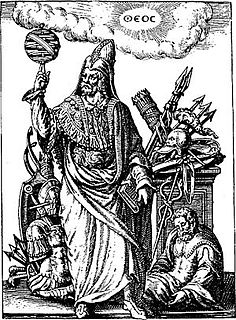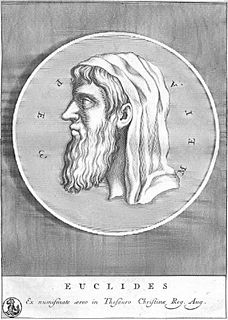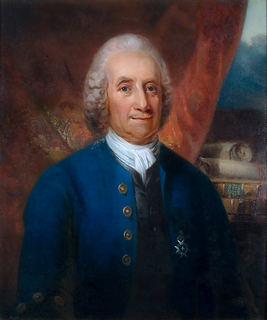Pre-Socratic philosophy, also known as early Greek philosophy, is ancient Greek philosophy before Socrates. Pre-Socratic philosophers were mostly interested in cosmology, the beginning and the substance of the universe, but the inquiries of these early philosophers spanned the workings of the natural world as well as human society, ethics, and religion. They sought explanations based on natural law rather than the actions of gods. Their work and writing has been almost entirely lost. Knowledge of their views comes from testimonia, i.e. later authors' discussions of the work of pre-Socratics. Philosophy found fertile ground in the ancient Greek world because of the close ties with neighboring civilizations and the rise of autonomous civil entities, poleis.

Chrysippus of Soli was a Greek Stoic philosopher. He was a native of Soli, Cilicia, but moved to Athens as a young man, where he became a pupil of Cleanthes in the Stoic school. When Cleanthes died, around 230 BC, Chrysippus became the third head of the school. A prolific writer, Chrysippus expanded the fundamental doctrines of Zeno of Citium, the founder of the school, which earned him the title of Second Founder of Stoicism.

Robert Fludd, also known as Robertus de Fluctibus, was a prominent English Paracelsian physician with both scientific and occult interests. He is remembered as an astrologer, mathematician, cosmologist, Qabalist and Rosicrucian.

Hermeticism, or Hermetism, is a label used to designate a philosophical system that is primarily based on the purported teachings of Hermes Trismegistus. These teachings are contained in the various writings attributed to Hermes, which were produced over a period spanning many centuries, and may be very different in content and scope.

The Hermetica are the philosophical texts attributed to the legendary Hellenistic figure Hermes Trismegistus. These texts may vary widely in content and purpose, but are usually subdivided into two main categories:

Euclid of Megara was a Greek Socratic philosopher who founded the Megarian school of philosophy. He was a pupil of Socrates in the late 5th century BC, and was present at his death. He held the supreme good to be one, eternal and unchangeable, and denied the existence of anything contrary to the good. Editors and translators in the Middle Ages often confused him with Euclid of Alexandria when discussing the latter's Elements.
The world soul is, according to several systems of thought, an intrinsic connection between all living things on the planet, which relates to the world in much the same way as the soul is connected to the human body. Plato adhered to this idea and it was an important component of most Neoplatonic systems:
Therefore, we may consequently state that: this world is indeed a living being endowed with a soul and intelligence ... a single visible living entity containing all other living entities, which by their nature are all related.

Correspondence is a relationship between two levels of existence. The term was coined by the 18th-century theologian Emanuel Swedenborg in his Arcana Cœlestia (1749–1756), Heaven and Hell (1758) and other works.

Analogies between microcosm and macrocosm are found throughout the history of Jewish philosophy. According to this analogy, there is a structural similarity between the human being and the cosmos as a whole.

Wisdom literature is a genre of literature common in the ancient Near East. It consists of statements by sages and the wise that offer teachings about divinity and virtue. Although this genre uses techniques of traditional oral storytelling, it was disseminated in written form.

In astronomy, axis mundi is the Latin term for the axis of Earth between the celestial poles.
According to ancient and medieval science, aether, also spelled æther, aither, or ether and also called quintessence, is the material that fills the region of the universe above the terrestrial sphere. The concept of aether was used in several theories to explain several natural phenomena, such as the traveling of light and gravity. In the late 19th century, physicists postulated that aether permeated all throughout space, providing a medium through which light could travel in a vacuum, but evidence for the presence of such a medium was not found in the Michelson–Morley experiment, and this result has been interpreted as meaning that no such luminiferous aether exists.

The Kybalion is a book originally published in 1908 by "Three Initiates" that purports to convey the teachings of Hermes Trismegistus. A modern Hermetic tract, it has been widely influential in New Age circles since the twentieth century.
Cosmographia ("Cosmography"), also known as De mundi universitate, is a Latin philosophical allegory, dealing with the creation of the universe, by the twelfth-century author Bernardus Silvestris. In form, it is a prosimetrum, in which passages of prose alternate with verse passages in various classical meters. The philosophical basis of the work is the Platonism of contemporary philosophers associated with the cathedral school of Chartres—one of whom, Thierry of Chartres, is the dedicatee of the work. According to a marginal note in one early manuscript, the Cosmographia was recited before Pope Eugene III when he was traveling in France (1147–48).
This page is a list of topics in ancient philosophy.

Stoicism is a school of Hellenistic philosophy founded by Zeno of Citium in Athens in the early 3rd century BC. It is a philosophy of personal ethics informed by its system of logic and its views on the natural world. According to its teachings, as social beings, the path to eudaimonia is found in accepting the moment as it presents itself, by not allowing oneself to be controlled by the desire for pleasure or by the fear of pain, by using one's mind to understand the world and to do one's part in nature's plan, and by working together and treating others fairly and justly.
Academic skepticism refers to the skeptical period of ancient Platonism dating from around 266 BC, when Arcesilaus became scholarch of the Platonic Academy, until around 90 BC, when Antiochus of Ascalon rejected skepticism, although individual philosophers, such as Favorinus and his teacher Plutarch, continued to defend skepticism after this date. Unlike the existing school of skepticism, the Pyrrhonists, they maintained that knowledge of things is impossible. Ideas or notions are never true; nevertheless, there are degrees of plausibility, and hence degrees of belief, which allow one to act. The school was characterized by its attacks on the Stoics, particularly their dogma that convincing impressions led to true knowledge. The most important Academics were Arcesilaus, Carneades, and Philo of Larissa. The most extensive ancient source of information about Academic skepticism is Academica, written by the Academic skeptic philosopher Cicero.

"As above, so below" is a popular modern paraphrase of the second verse of the Emerald Tablet, as it appears in its most widely divulged medieval Latin translation:
Quod est superius est sicut quod inferius, et quod inferius est sicut quod est superius.
That which is above is like to that which is below, and that which is below is like to that which is above.

Advayataraka Upanishad is an ancient Sanskrit text and a minor Upanishad of Hinduism. It is one of the 19 Upanishads attached to the Shukla Yajurveda. It is classified as a Yoga Upanishad.














